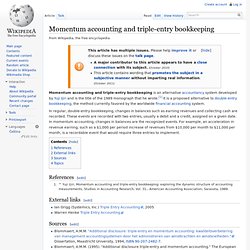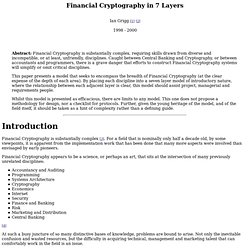

Financial Cryptography: Is BitCoin a triple entry system? Is BitCoin a triple entry system?

James Donald recently gave me a foil on which to ask this interesting question. Although it took me a while to sort the wheat from the chaff, I'm finally getting to grips with the architecture. On 13/06/11 12:56 PM, James A. Donald wrote: > On 2011-06-12 8:57 AM, Ian G wrote: > > I wrote a paper about John Levine's observation of low knowledge, way > > back in 2000, called "Financial Cryptography in 7 Layers. " The sort of > > unstated thesis of this paper was that in order to understand this area > > you had to become very multi-discipline, you had to understand up to 7 > > general areas. Yes, so back to crypto, or at least financial cryptography. The accounting layer in a money system implemented in financial cryptography is responsible for reliably [1] holding and reporting the numbers for every transaction and producing an overall balance sheet of an issue.
Master Mentor Accounting Giant: Yuji Ijiri. Triple Entry Accounting. Work - in - Progress Triple Entry Accounting Ian Grigg Systemics, Inc. 2005 $Revision: 1.7 $$Date: 2005/12/25 23:04:21 $ Abstract: The digitally signed receipt, an innovation from financial cryptography, presents a challenge to classical double entry bookkeeping.

Rather than compete, the two melded together form a stronger system. Introduction This paper brings together financial cryptography innovations such as the Signed Receipt with the standard accountancy techniques of double entry bookkeeping. The first section presents a brief backgrounder to explain the importance of double entry bookkeeping. The third section integrates the two together and the Conclusion attempts to predict wider ramifications into Governance issues. Credits This paper benefitted from comments by Graeme Burnett and Todd Boyle [TB]. A Very Brief History of Accounting Single Entry Single entry bookkeeping is how 'everyone' would do accounting: start a list, and add in entries that describe each asset.
Momentum accounting and triple-entry bookkeeping. Momentum accounting and triple-entry bookkeeping is an alternative accountancy system developed by Yuji Ijiri and is the title of the 1989 monograph that he wrote.[1] It is a proposed alternative to double-entry bookkeeping, the method currently favored by the worldwide financial accounting system.

In regular, double-entry bookkeeping, changes in balances such as earning revenues and collecting cash are recorded. These events are recorded with two entries, usually a debit and a credit, assigned on a given date. In momentum accounting, changes in balances are the recognized events. For example, an acceleration in revenue earning, such as a $1,000 per period increase of revenues from $10,000 per month to $11,000 per month, is a recordable event that would require three entries to implement. References[edit] External links[edit] Sources[edit] Blommaert, A.M.M. Topics[edit] Triple Entry Accounting. I wrote the following article in 1994 while working on my Masters degree.

Although it is written in the lingo and jargon of a student trying to impress a professor for a grade, I still like it (hehe). In conjunction with writing this paper, we were required to make a presentation to our faculty and peers. The paper and presentation were the entire basis for our grade in this particular class. Accountants are typically conservative and professional individuals. Our presentations were to be as professional as possible (board room setting, suits, big-business scenario…). (Just to let you know, my gamble paid off. I believe that current accounting practices are based on methods and processes that are outdated. “Budgets,” you say? The past few years I have been thinking more in terms of personal finances, rather the corporate accounting. [PDF] Accounting in three dimensions — a case for momentum revisited. Financial Cryptography in 7 Layers. Financial Cryptography in 7 Layers Ian Grigg [1] [2] Abstract: Financial Cryptography is substantially complex, requiring skills drawn from diverse and incompatible, or at least, unfriendly, disciplines.

Caught between Central Banking and Cryptography, or between accountants and programmers, there is a grave danger that efforts to construct Financial Cryptography systems will simplify or omit critical disciplines. This paper presents a model that seeks to encompass the breadth of Financial Cryptography (at the clear expense of the depth of each area). By placing each discipline into a seven layer model of introductory nature, where the relationship between each adjacent layer is clear, this model should assist project, managerial and requirements people.